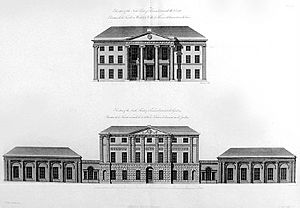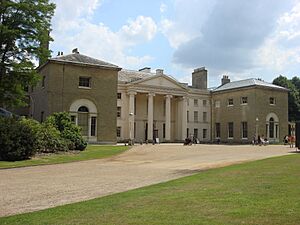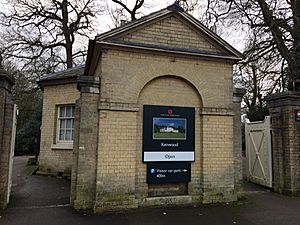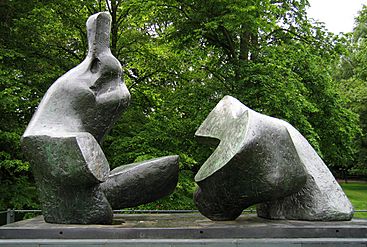Kenwood House facts for kids
Quick facts for kids Kenwood House |
|
|---|---|
 |
|
| Type | English country house |
| Location | Hampstead Heath, NW3 |
| Area | London Borough of Camden |
| Built | 17th century |
| Rebuilt | 1764–1779 |
| Architect | Robert Adam (18th century remodelling) |
| Architectural style(s) | Georgian and Neoclassical |
| Owner | Historic England |
|
Listed Building – Grade I
|
|
| Official name: Kenwood House (Iveagh Bequest) | |
| Designated | 10 June 1954 |
| Reference no. | 1379242 |
|
Listed Building – Grade II*
|
|
| Official name: Service wing and outbuildings to Kenwood House | |
| Reference no. | 1379244 |
|
Listed Building – Grade II*
|
|
| Official name: Sham bridge to south of Kenwood House | |
| Reference no. | 1379245 |
| Designated | 1 October 1987 |
| Reference no. | 1000142 |
| Lua error in Module:Location_map at line 420: attempt to index field 'wikibase' (a nil value). | |
Kenwood House is a beautiful historic home in Hampstead, London. It sits right on the edge of Hampstead Heath, a large park. This grand house was built in the late 1600s. Later, in the 1700s, a famous architect named Robert Adam redesigned it. It was once the home of the Earls of Mansfield for many years.
In 1925, Edward Guinness, 1st Earl of Iveagh, bought the house and some of its land. He then gave it to the nation in 1927. The entire estate became public property and opened to visitors. Today, Kenwood House is a popular place for people to visit and explore.
Contents
Where is Kenwood House?
Kenwood House is located on the northern side of Hampstead Heath. It is in the London Borough of Camden. The house is just south of the border with the London Borough of Haringey.
History of Kenwood House
Early Beginnings
The first house on this land was likely built around 1616. It was owned by John Bill, who was the King's Printer. Back then, it was called Caen Wood House. In 1694, William Bridges bought the property. He tore down the old house and built a new one. The original brick structure is still there, hidden under the newer walls. An orangery, a special greenhouse for orange trees, was added around 1700. The house changed owners several times. In 1754, William Murray, 1st Earl of Mansfield, bought it. He was a very important judge, the Lord Chief Justice.
The Mansfield Family Era
In 1764, Lord Mansfield hired Robert Adam to redesign the house. Adam was given complete freedom to create his vision. He added the famous library, which is one of his best designs. This library was built to hold Lord Mansfield's huge collection of books. Adam also designed the grand entrance with its Ionic columns.
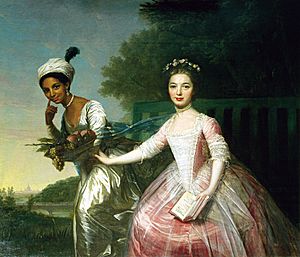
In 1780, there were riots in London. Lord Mansfield's home in the city was destroyed. The rioters then planned to attack Kenwood House. To stop them, free drinks were given out at a nearby inn. This helped delay the crowds until soldiers arrived to protect the house.
After the 1st Earl died in 1793, his nephew, David Murray, became the owner. He decided to make the house even bigger. New wings were added to the north side. One wing became the first permanent dining room. Other buildings were added for offices, a kitchen, and a brewery. A dairy was also built to provide milk and cheese. The main road near the house was moved between 1793 and 1796. This made sure it did not run right next to the property.
In 1794, King George III visited Kenwood House. He was very interested in the new architectural changes.
The 2nd Earl died in 1796. His son, David William Murray, became the 3rd Earl. Important repairs were done to the house between 1803 and 1839. These repairs helped make sure Kenwood would last for a long time. The Mansfield family owned the house for the rest of the 1800s. However, they preferred to live at their other home, Scone Palace in Scotland.
In 1835, King William IV and Queen Adelaide visited Kenwood. About 800 important guests attended the event in the gardens.
In 1906, Alan David Murray became the 6th Earl of Mansfield. He decided to sell Kenwood. In 1910, Grand Duke Michael Mikhailovich of Russia and his wife leased the house. They hosted a big dinner and ball in 1914. King George V and Queen Mary were among the royal guests. The Grand Duke stayed until 1917. After him, an American millionaire, Nancy Leeds, lived there until 1920. In 1922, Lord Mansfield sold off all the furniture and art from the house. Its future was uncertain.
Kenwood House Today
In 1922, a group called the Kenwood Preservation Council bought some of the land. This was to stop it from being sold for building. The land became public in 1924. King George V opened it to the public the next year. In 1925, Edward Guinness, 1st Earl of Iveagh, bought the house and the rest of the land. He gave it to the nation when he died in 1927. The house opened to the public in 1928. Some of the furniture that was sold in 1922 has since been bought back. The paintings you see there today are from Lord Iveagh's own collection.
Kenwood House closed at the start of World War II. After the war, it reopened in 1950. The parts added in the late 1700s were restored between 1955 and 1959. In 1986, English Heritage took over caring for the estate.
The house was closed for big renovations from 2012 to late 2013. This work included fixing the roof and rearranging the paintings. The goal was to make the house look more like Robert Adam's original design.
In 2019, over 134,000 people visited Kenwood House.
The Kenwood Estate
There are two paths leading to the house from Hampstead Lane. Each path has a small, white-brick building called a lodge. The main entrance of the house faces north. It was designed by Robert Adam and has a central porch. The south side of the house was restored in 1975 to its original look. To the east of the house is the service wing, made of London brick. Across from this is a brick building that was once a cold-plunge bath.
The estate has beautiful gardens near the house. These were likely designed by Humphry Repton. There are also woodlands and the natural Hampstead Heath to the south. A garden designed by Arabella Lennox-Boyd is also part of the estate.
The estate is listed as a Grade II* historic park and garden. This means it is very important. One-third of the estate is a special protected area. This includes old woodlands. These woods are home to many birds and insects. They also have the largest group of Pipistrelle bats in London.
You can find sculptures by famous artists like Barbara Hepworth, Henry Moore, and Eugène Dodeigne in the gardens.
|
For many years, music concerts were held by the lake every summer. These concerts, which included classical and pop music, were very popular. People would picnic and enjoy the music and fireworks. In 2007, these concerts stopped for a while. They returned in 2008 to a new spot on the estate. The number of concerts each season was limited to eight.
Art Collection

Kenwood House has a large collection of historic paintings and artworks. There are 63 paintings by Old Master artists. Some famous paintings include:
- The Guitar Player by Johannes Vermeer
- Self Portrait with Two Circles, a late self-portrait by Rembrandt
- Portrait of Pieter van den Broecke, by Frans Hals
- Portrait of Countess Howe by Thomas Gainsborough
Other artists whose works are displayed include:
- Joshua Reynolds
- Angelica Kauffman
- J. M. W. Turner
- François Boucher
- Thomas Lawrence
- Henry Raeburn
- George Romney
- Joseph Wright of Derby
Most of these artworks were bought by Lord Iveagh in the 1880s and 1890s. They are mainly portraits, landscapes, and Dutch and Flemish works from the 1600s. Some other pieces were added later because they had a connection to Kenwood House.
The house also has a collection of shoe buckles, jewelry, and tiny portrait miniatures.
In 2002, some Stuart-era portraits were moved to Kenwood from Ranger's House in Greenwich.
In 2012, while Kenwood House was being renovated, some of its art went on a tour of museums in the United States. Many of these artworks had never left Britain before. The exhibit opened in June 2013 in Little Rock, Arkansas.
See also
 In Spanish: Kenwood House para niños
In Spanish: Kenwood House para niños


